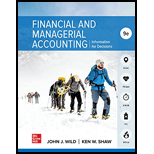
1.
Concept Introduction:
The number of assets invested in A in the current year.
2.
Concept Introduction:
Return on assets: The return on assets provides a measure of the profitability of assets. To derive this ratio, the net income is divided by the average total assets.
The return on assets during the current year for A.
3.
Concept Introduction:
Accounting equation: The relation of assets, liability, and equity is reflected in the accounting equation. Assets are resources a company owns or controls, whereas liabilities are what a company owes to outsiders and equity is the claims of the owners on the assets of the company.
The total expenses for A during the current year.
4.
Concept Introduction:
Return on assets: The return on assets provides a measure of the profitability of assets. To derive this ratio, the net income is divided by the average total assets.
The comparison of current year return on assets with competitors' return on assets of 10%.
Want to see the full answer?
Check out a sample textbook solution
Chapter 1 Solutions
Financial and Managerial Accounting
- PROBLEM 11-17 Return on Investment (ROI) and Residual Income LO11-1, LO11-2 Financial data for Joel de Paris, Inc., for last year follow: Joel de Paris, Inc. Balance Sheet Beginning Ending Balance Balance Assets Cash $ 140,000 $ 120,000 Accounts receivable 450,000 530,000 Inventory 320,000 380,000 Plant and equipment, net 680,000 620,000 Investment in Buisson, S.A. 280,000 170,000 250,000 Land (undeveloped) 180,000 Total assets $2,020,000 $2,100,000 Liabilities and Stockholders' Equity Accounts payable. $ 360,000 $ 310,000 Long-term debt Stockholders' equity 1,500,000 1,500,000 160,000 290,000 Total liabilities and stockholders' equity $2,020,000 $2,100,000 Joel de Paris, Inc. Income Statement Sales $4,050,000 Operating expenses Net operating income 3,645,000 405,000 Interest and taxes: Interest expense $150,000 Таx expense 110,000 260,000 Net income $ 145,000 The company paid dividends of $15,000 last year. The "Investment in Buisson, S.A.," on the balance sheet represents an…arrow_forwardCalculate the profit margin, basic earning power (BEP), return on assets (ROA), and return on equity (ROE). How has the company’s profitability changed during the last year? A computer manufacturer has financial statements as follows: Income Statements for Year Ending December 31 (Thousands of Dollars) 2019 2018 Sales $945,000 $900,000 Expenses excluding depreciation and amortization 812,700 774,000 EBITDA $132,300 $126,000 Depreciation and amortization 33,100 31,500 EBIT $99,200 $94,500 Interest Expense 10,470 8,600 EBT $88,730 $85,900 Taxes (25%) 22,183 21,475 Net income $66,547 $64,425 Common dividends $56,609 $54,115 Addition to retained earnings $9,938 $10,310 Balance Sheets for Year Ending December 31 (Thousands of Dollars) Assets 2019 2018 Cash and…arrow_forwardWhat is the current-year return on assets for (a) Apple and (b) Google?arrow_forward
- Please describe what is meant by “Times Interest Earned.” How is it calculated? Suppose you calculated this ratio for a company for two consecutive years and the results were the following: year 2018 – 24.0 year 2017 – 28.0 Please interpret the results. What conclusions can you draw?arrow_forwardTime series analysis involves comparing a company’s income statement and balance sheet forthe current year to its previous years’ income statements and balance sheets.Required:Explain whether it is always bad if a company’s cost of goods sold is increasing from year to year.arrow_forwardCase Study Questions What was the total postpaid revenue in 2017? What was the total net profit in 2017? Identify examples of strategies adopted by MAXIS in that year. How were the above strategies related to their Customer Relationship Management (CRM) and future sale?arrow_forward
- Search online for Tesla’s Annual Report for fiscal year 2020 that ended on December 31, 2020. Answer the following questions using the report. What’s Tesla’s current ratio in 2019 and 2020? What does this ratio suggest? What’s Tesla’s net profit margin and gross profit percentage in 2019 and 2020? What’s your interpretation of the trend? What’s Tesla’s return on assets(ROA) and total asset turnover ratio in 2020?arrow_forwardAttached is Apple Inc.'s financial information. Please answer questions 1-4. 1. Apple's working capital turnover in 2021 is a. 17.27 b. 19.18 c. 14.82 d. 15.35 2. Apple's days to sell inventory in 2021 is a. 8.99 b. 10.82 c. 9.73 d. 7.61 3. Apple's return on assets ratio in 2021 is a. 0.46 b. 0.37 c. 0.18 d. 0.29 4. Apple's times interest rate earned ratio in 2021 is a. 24.38 b. 19.36 c. 37.47 d. 42.21arrow_forwardusing the total for income and expense, what is the income statement equation for the most recent year? what amount of net sale is reported for each year? what is the % change in sales for each year and the trend in revenues? Operating activities Net income $6,177.4 $ 7,545.2 $ 4,730.5 Adjustments to reconcile to cash provided by operations Charges and credits: Depreciation and amortization 1,870.6 1,868.1 1,751.4 Deferred income taxes (345.7) (428.3) 6.4 Share-based compensation 166.7 139.2 92.4 Net (gain) loss on sale of restaurant and other businesses Other 732.7 (97.8) (28.2) (570.4) (339.1) (75.2) Changes in working capital items: Accounts receivable (264.1) 309.9 (6.8) Inventories, prepaid expenses and other current assets 5.6 (62.2) (68.6) Accounts payable 31.3 225.0 (137.5) Income taxes (546.7) (302.5) (43.6) Other accrued liabilities 129.3 284.0 44.4 Cash provided by operations 7,386.7 9,141.5 6,265.2 Investing activities Capital expenditures (1,899.2) (2,040.0) (1,640.8)…arrow_forward
- 1. What is the amount of sales for the year? 2. What is the amount of purchases for the year? 3. What is the net income for the year? 5. What is the amount of shareholders' equity on December 31?arrow_forwardHow much net income did H&M’s tool, incorporated, generate during 2021? What was the net profit margin? Is the company financed primarily by liabilities or stock holders equity? What is its current ratio?arrow_forwardHow much is the balance of Investment in Love Company at the end of the current year?arrow_forward
 Cornerstones of Financial AccountingAccountingISBN:9781337690881Author:Jay Rich, Jeff JonesPublisher:Cengage Learning
Cornerstones of Financial AccountingAccountingISBN:9781337690881Author:Jay Rich, Jeff JonesPublisher:Cengage Learning Managerial AccountingAccountingISBN:9781337912020Author:Carl Warren, Ph.d. Cma William B. TaylerPublisher:South-Western College Pub
Managerial AccountingAccountingISBN:9781337912020Author:Carl Warren, Ph.d. Cma William B. TaylerPublisher:South-Western College Pub




